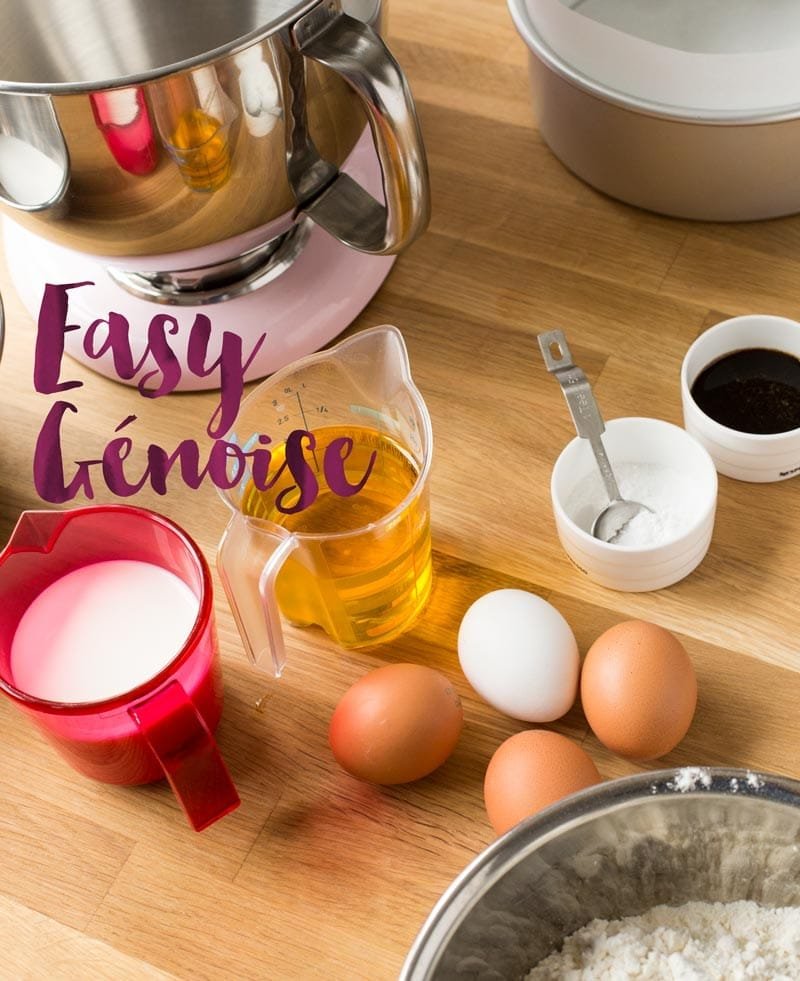Happy Easter! What is easy genoise? I’ve been researching different types of sponges lately. There are so many methods of mixing batters and combining sugar, flour, eggs and fats.
Depending on how you’re planning to use your sponges, you’ll be looking for lighter or a more compact consistency.
What’s the difference between a sponge cake, a génoise, a chiffon cake, and angel food cake, pound cake etc.? I’ll be exploring this question in this series:

I think you’ll agree with me that we are always searching for the fluffiest, but still moist and flavorful sponge available. The cake should keep its shape during torting, filling, carving, covering and not crumble apart or sag under the weight. And yet, when we take a bite, it should should feel light and melt in the mouth. It should not be too dry or too pasty. The cake should have a nice flavor, that complements the flavor of the filling well. Phew- that is a lot of requirements!
According to cake guru Rose Levy Beranbaum, author of “The Cake Bible” which I’m reading these days, cake mixtures can be spilt into two general categories:
Group 1: Butter cakes
These batters are usually mixed with all the ingredients in a single bowl and yield a buttery, denser kind of cake, that is suitable for covering in fondant, carving and that does holds its shape well. While the ingredients can be mixed in several ways, the classic method of butter cake starts by creaming butter and sugar for several minutes in a mixer to create an emulsion, then adding eggs, and finally flour, leavening agent and liquid. Butter cakes have rich buttery taste that can be overwhelming if served in large quantities. They stay moist and fresh almost indefinitely when frozen. Butter cakes include butter cake, pound cake, sand cakes and the english Victoria sponge.
Group 2: Sponge cakes
These batters usually get their light and airy texture from separately foamed egg whites or whole eggs. While the most classic sponge is made just from eggs, flour and sugar with no additional fat or baking powder, there exist many variations. While these sponges are delightful to eat thanks to their lightness, they are also very fragile and don’t hold the weight of ganache or fondant very well. They are best served with a light filling such as whipped cream or jam, and without any covering, except for maybe a thin layer of buttercream, or drizzled with ganache. They also tend to dry out more quickly than butter cakes. Sponge cakes include classic genoise, angel food cake, roulades like Swiss rolls, Pan di Spagna and chiffon cake.
As you can see, both categories have advantages and drawbacks. And of course, there exist many recipes that are cross-sections and combine techniques from both groups.
Just a little while ago, I discovered a great recipe that seems to combine the best properties of both categories: The “Wunderrezept” (wonder recipe) from the German forum “Torten-Talk”. It’s incredibly versatile and you can alter many of the elements to fit your taste. (Here’s a strawberry version for you). Today I’m posting the vanilla version for you – I call it “Easy Genoise” because the mixing method is most similar to a genoise cake.
It’s a simplified version of the classic genoise (which involves lots of steps like melting butter to a perfect “beurre noisette”, heating eggs over a water bath etc.): In this recipe you can beat the whole eggs with the sugar for at least 10 minutes to create a stable egg foam. Instead of butter, this recipe uses oil (read more about baking with oil in this post). Today we are adding milk as a liquid, but you can use anything you like.
We only use one bowl to mix everything together. The result: A flat, fluffy, soft and juicy sponge that melts in the mouth but is still stable enough to fill with buttercream and cover in fondant.
Easy Genoise video instructions:
And here’s the easy genoise recipe for you:
Easy Genoise (vanilla wonder recipe)
Ingredients
- 200 g (1 cup) sugar
- 4 eggs
- 1/2 teaspoon salt
- 200 ml (0.8 cup) milk
- 185 g (0.8 cups) vegetable oil (I like butter-flavored oil such as Alba-oil)
- 3 tablespoons vanilla extract
- 300 g (2.4 cups) all purpose flour
- 3 teaspoons (16 g) baking powder
Preparation
- Preheat oven to 180 c (350 F). Line two 20cm (8″) baking tins with baking paper (or grease + flour them).
- Place the eggs in a small bowl and cover them with hot tap water for 5 minutes. Then place sugar, eggs and salt in the bowl of your mixer and beat on high speed for at least 10 minutes. If using a hand mixer, go for 15 minutes.
- While the mixer is working, in a separate bowl sift together flour and baking powder. Set aside.
- Mix together the milk, oil and vanilla in a bowl. As soon as the eggs are ready, turn the mixer to the slowest speed and pour the liquid in swiftly (not too slowly but not all at once either!).
- Immediately pour the batter into your prepared baking tins and place in the oven. Bake for about 40 minutes, or until a toothpick comes out clean.
- Let the sponges cool for about 15 minutes on a rack, before unmolding. As soon as they cool down (after 1 hour or so), immediately wrap in cling film to prevent drying.
4. As soon as the milk and oil are mixed with the eggs, fold in the flour mixture very carefully with the mixer on slowest speed or even better, by hand. Mix until just combined.
The easy genoise keeps in the fridge for 3 days. Freezes well for a month. Always chill prior to torting and filling.
Please leave your comments or questions below!
Happy baking!
Love,


Wow this looks so moist and delicious cant wait to try my hands on this wonderful recipe.
Hi Minh! This looks delicious! I’m wondering do you think it would be good to separate the egg whites and fold it in the end?
Hi Linh. You could, but the idea behind this cake is to eliminate all the extra work and extra mixing bowls! If you are extra careful with folding the flour at the end, there is no need to separate the egg whites. Let me know how it goes when you try it. Happy baking, XM